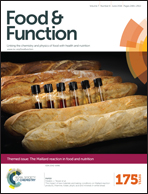The inhibitory kinetics and mechanism of dietary vitamins D3 and B2 on xanthine oxidase
Abstract
Dietary guidelines to promote health are usually based on the patterns’ prediction on disease risk of foods and nutrients. Overactivity of xanthine oxidase (XO) is the underlying cause of gout. Herein, the inhibitory kinetics and mechanism of dietary vitamins D3 and B2 on XO were investigated by multispectroscopic methods and a molecular modeling technique. The results showed that vitamin D3 competitively inhibited XO with an inhibition constant of 26.93 ± 0.42 μM by inserting into the active cavity of XO interacting with the surrounding amino acid residues through hydrogen bond and van der Waals forces. Vitamin D3 bound to XO thereby induced the structural compactness of XO which in turn hindered the binding of substrate xanthine to cause the inhibition on XO. Vitamin B2 exhibited a mixed-type inhibition by binding to the vicinity of the active cavity with an inhibition constant of 37.76 ± 0.87 μM through hydrophobic interactions and a feeble hydrogen bond, and it induced the unfolding of the XO structure and an increase of the flexible loops (β-turns and random coils) which might move to cover the active pocket and reduce the binding of the substrate xanthine, and then lead to a lower catalytic activity of the enzyme. In addition, vitamins D3 and B2 showed a synergistic effect on inhibiting the activity of XO in a certain range of concentration. These findings may provide new insights into the inhibitory mechanism of vitamins D3 and B2 on XO and functional research of the vitamins in the supplementary treatment of gout.


 Please wait while we load your content...
Please wait while we load your content...